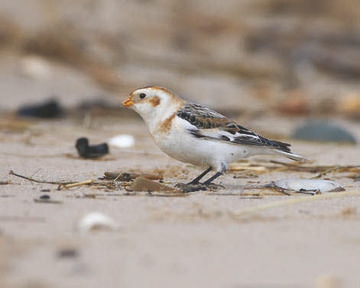Snow Bunting (Plectrophenax nivalis)

Snow Bunting © Richard Steel
Probably ten thousand or more Snow Buntings winter in Britain, mostly along the east coast and the highest hills, but few of them make it to Cheshire and Wirral (BTO Winter Atlas). The numbers vary greatly from one year to another. Its rarity and unpredictability, together with the attractiveness of the species make this a bird that is much sought after to brighten a winter’s day. They have, however, become distinctly scarcer in recent years, perhaps because of the warming climate.
Snow Buntings have a circumpolar breeding range on the Arctic tundra, with another race (insulae), darker and more sedentary, breeding in Iceland and the Scottish mountains: both races winter here, with the birds of the nominate race thought to be from Scandinavia and Greenland. Most of those wintering in England are females and first-year birds (Brown & Grice 2005), males tending to winter farther north, closer to or even on their breeding territories; within Britain, males and adults are likely to winter in montane sites rather than the coast (Migration Atlas). As a bird of short, open vegetation, feeding by picking seeds from the ground or low creeping plants, Snow Buntings frequent two habitats, at the lowest and highest altitudes. They particularly favour sandy shores with a carpet of dune colonising plants or the lower levels of saltmarshes. In upland areas the main diet is probably seeds of rushes juncus, although they will take seeds from moor grasses and heather. They also take invertebrates when they can, especially sandhoppers on the shore.
The records during this winter Atlas were typical of recent years, with birds in five tetrads in 2004/ 05, in three tetrads during 2005/ 06, and three tetrads in 2006/ 07. Hilbre Island (SJ18Z) had one bird in each winter, and birds were in West Kirby (SJ28D) in 2004/ 05 and 2006/ 07. All of the Atlas records were of single birds apart from a group of five at Red Rocks (SJ28E). The bird seen by John Oxenham on 3 December 2004 at Birchenough Hill (SJ96Z), 450 m above sea level, was the first in the hills since one in 2001/ 02.
The coast and the Dee estuary have always attracted the species: Coward (1910) described it as ‘a fairly regular winter visitor to the coast’. In more recent times, the county bird reports since 1959 show Snow Buntings in the county in every winter apart from 1994/ 95, mainly at coastal sites. Leasowe Sandhills (SJ29R) used regularly to hold flocks of 20-40 birds, with a maximum of 70, but was lost to development in the early 1970s and since 1972 there have only been two winters with double figure flocks along the north Wirral shore. As during this winter Atlas, Hilbre has been the most reliable site for the species, with single birds in many years but flocks of ten or more in nine winters in the period 1961-2006, most recently in 1998. Along the Mersey small numbers were recorded sporadically in winter until 1982, but there have only been isolated winter records since. In the eastern hills, birds used to be regular, perhaps even annual, until 1934 but records then almost ceased and they are much scarcer now. Since 1961 there have been records in eight years, all on single dates in November and December and mostly of lone birds apart from parties of five on 8 December 1981 and nine on 23 November 1988, both on the slopes of Shutlingsloe (SJ96U). There have been occasional odd birds in the Cheshire Plain, but only six records of single birds in the last fifty years.
Sponsored by Syngenta CTL

